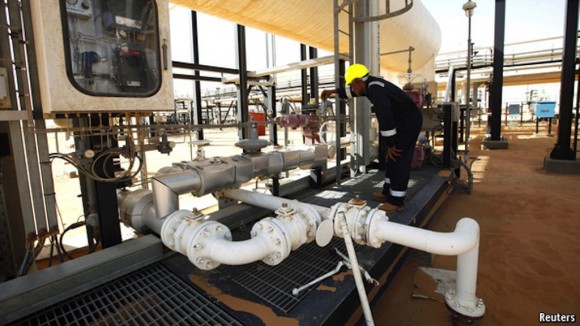 As the oil price plunges, gloom and ill-will, oddly, abound
As the oil price plunges, gloom and ill-will, oddly, abound
BE CAREFUL what you wish for. After years of grumbles about a historically high oil price, the cost of crude has tumbled. But cries of woe are outnumbering the shouts of joy. Exporters, oil-company shareholders and industry suppliers are all contemplating a future of oil at $60 a barrel—or below. So too are all the people who lent money to them. Markets are pricing in the pain and pessimism immediately, while seeming to discount the future gains to energy users.
Russia’s currency is at a record low, falling below 60 roubles to the dollar on December 15th. Indonesia’s rupiah is at its weakest for six years. The FTSE 100, a London-based stock market index dominated by extractive-industry shares, had its worst week since August 2011, with a 6.3% fall. European equities across the continent suffered their biggest weekly loss in more than three years. Emerging market stocks are also down to a nine-month low.
Over the weekend Abdallah Salem el-Badri, secretary general of the Organisation of Oil Exporting Countries, (OPEC), a cartel which produces 40% of the world’s oil, said he saw no grounds for production cuts. “The decision has been made. Things will be left as is,” he said. That was the first official comment from OPEC since its meeting in Vienna at the start of this month, at which it decided not to try to curb production in order to support prices.
That will be little comfort to those squeezed by the 50% fall in the price of oil from its peak three years ago. Mr el-Badri says he believes that the drop is excessive. “The fundamentals should not lead to this dramatic reduction [in price],” he said. OPEC was “assessing the situation” to determine the real reasons behind the decrease.
That assessment should not take too long. Increased efficiency, weak economic growth and the use of alternative energy sources are all dampening demand. The International Energy Agency (IEA), an intergovernmental body which represents the industrialised economies that consume oil and gas, has cut its forecast. It believes that demand will grow only by 0.9 million barrels a day (mb/d) in 2015 to 93.3 mb/d.
Weak demand is only a minor factor, though. The biggest cause of the falling price is rising supply from non-OPEC countries, particularly from America. The IEA believes that American supply will raise total non-OPEC production by a record 1.9 mb/d in 2015. In theory, lower oil prices will curb that. Spending on new projects is falling, chilling the prospects for jobs and profits.
But such effects come with a lag. Once wells are drilled, it makes sense to pump them. As the IEA notes “Today’s oil spending cuts will dent supply—just not right now.” The short-term outlook for American shale oil production, known as “light tight oil”, remains unchanged it reckons, so long as the producers do not actually go bust (and perhaps not even then–someone else will buy the well). The only place where oil production is likely to fall immediately, it reckons, is Russia, where the combination of sanctions and a collapsing currency may trim production.
So news that fighting has closed two oil-export terminals in Libya—something that would normally have spooked markets—has cheered them instead. Libya is a small oil producer, with about 900,000 barrels a day (b/d), around half its peacetime production. But the belief that geopolitical risk is not dead has put a little resilience back into prices.
The burning question for those hit by falling prices is what if anything OPEC and other producers are going to do. The answer so far seems to be “not much”. Russia (a non-member), Venezuela and other hard-pressed countries want an emergency meeting of OPEC. But the Saudis and their Gulf allies—the biggest force in the cartel—are not interested. They prefer to keep market share. Only a real commitment from the non-OPEC countries to make production cuts themselves would spur the Saudis to turn off the pumps. There seems little chance of that right now.
In theory, lower prices should boost demand. That is the assumption of research by the International Monetary Fund (IMF), which suggests that a 25% drop in oil prices boosts oil demand by around 0.4 mb/d. But the IEA disputes that. It thinks that some of the falling demand is structural, not cyclical. And governments may respond to the falling prices to cut subsidies. China, Indonesia, Kuwait, India, Thailand, Egypt and Malaysia have all taken this step. Kuwait has announced plans to triple diesel and kerosene prices (though not gasoline) in 2015. That will help keep demand weak.
So long as the era of excess supply and declining profits continues, rivets are popping. European refining margins are coming under pressure, because American competitors, stoked by cheap crude oil which cannot be exported, are sending what some call a “diesel tsunami” across the Atlantic. In Britain, thousands of jobs in the offshore oil and gas industry are at risk. Total full-year output for the entire North Sea is expected to decline to 840,000 b/d, its lowest level since 1977.
Hundreds of billions of dollars of investment are needed to extract the remaining reserves. Wood Mackenzie, a consultancy, says 32 potential European oilfield developments that could produce 4.9 billion barrels of oil may be mothballed if prices fall below $60 per barrel. BP, a London-based energy company, has already cut $1 billion from its capital expenditure plans. Other oil majors are following suit.
But such ructions are mild compared with Russia, where Rosneft, the partly state-owned oil giant, has been bailed out with cheap central bank cash to prevent it defaulting on its debts. But at least Russia has the foreign-currency reserves to do this: countries such as Venezuela may not be so lucky. However much oilmen may hope that the price will eventually recover, for now their woes are mounting.
